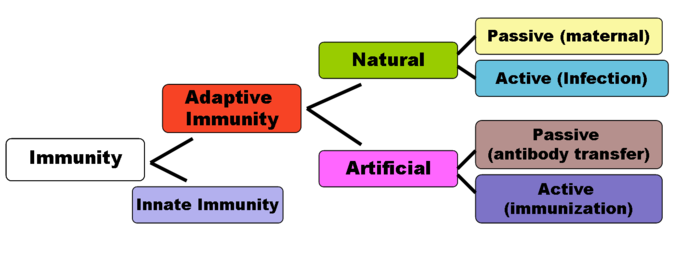11.12C: Artificial Immunity
- Page ID
- 11815
Artificial immunity is a mean by which the body is given immunity to a disease by intentional exposure to small quantities of it.
- Describe artificially acquired immunity and how it is obtained
Key Points
- The most common form of artificial immunity is classified as active and comes in the form of vaccinations, typically given to children and young adults.
- The passive form of artificial immunity involves introducing an antibody into the system once a person has already been infected with a disease, ultimately relieving the present symptoms of the sickness and preventing re-occurrence.
- Once the body has successfully rid itself of a disease caused by a certain pathogen, a second infection with the same pathogen would prove harmless.
Key Terms
- gamma globulin: a class of proteins in the blood, identified by their position after serum protein electrophoresis, such as antibodies
- anaphylactic shock: A severe and rapid systemic allergic reaction to an allergen, constricting the trachea and preventing breathing.
- herd immunity: the protection given to a community against an epidemic of a contagious disease when a sufficient number of the population are immunised or otherwise develop immunity to it
Immunity is the state of protection against infectious disease conferred either through an immune response generated by immunization or by previous infection or other non-immunological factors.
Artificial immunity can be active or passive.

Artificially-acquired passive immunity is an immediate, but short-term immunization provided by the injection of antibodies, such as gamma globulin, that are not produced by the recipient’s cells. These antibodies are developed in another individual or animal and then injected into another individual. Antiserum is the general term used for preparations that contains antibodies.
Artificial active immunization is where the microbe, or parts of it, are injected into the person before they are able to take it in naturally. If whole microbes are used, they are pre-treated, attenuated vaccines. This vaccine stimulates a primary response against the antigen in the recipient without causing symptoms of the disease.
Artificial passive immunization is normally administered by injection and is used if there has been a recent outbreak of a particular disease or as an emergency treatment for toxicity, as in for tetanus. The antibodies can be produced in animals, called ” serum therapy,” although there is a high chance of anaphylactic shock because of immunity against animal serum itself. Thus, humanized antibodies produced in vitro by cell culture are used instead if available.
The first record of artificial immunity was in relation to a disease known as smallpox. Individuals were exposed to a minor strain of smallpox in a controlled environment. Once their bodies built up a natural immunity or resistance to the weakened strain of smallpox, they became much less likely to become infected with the more deadly strains of the disease. In essence, patients were given the disease in order to help fight it later in life. Although this method was an effective one, the scientists of the time had no real scientific knowledge of why it worked.
LICENSES AND ATTRIBUTIONS
CC LICENSED CONTENT, SHARED PREVIOUSLY
- Curation and Revision. Provided by: Boundless.com. License: CC BY-SA: Attribution-ShareAlike
CC LICENSED CONTENT, SPECIFIC ATTRIBUTION
- vaccination. Provided by: Wiktionary. Located at: en.wiktionary.org/wiki/vaccination. License: CC BY-SA: Attribution-ShareAlike
- Active immunity. Provided by: Wikipedia. Located at: en.Wikipedia.org/wiki/Active_immunity. License: CC BY-SA: Attribution-ShareAlike
- immunity. Provided by: Wiktionary. Located at: en.wiktionary.org/wiki/immunity. License: CC BY-SA: Attribution-ShareAlike
- Typhoid inoculation2. Provided by: Wikipedia. Located at: en.Wikipedia.org/wiki/File:Ty...oculation2.jpg. License: CC BY-SA: Attribution-ShareAlike
- passive immunity. Provided by: Wiktionary. Located at: en.wiktionary.org/wiki/passive_immunity. License: CC BY-SA: Attribution-ShareAlike
- Passive immunity. Provided by: Wikipedia. Located at: en.Wikipedia.org/wiki/Passive_immunity. License: CC BY-SA: Attribution-ShareAlike
- IgG. Provided by: Wiktionary. Located at: en.wiktionary.org/wiki/IgG. License: CC BY-SA: Attribution-ShareAlike
- IgA. Provided by: Wikipedia. Located at: en.Wikipedia.org/wiki/IgA. License: CC BY-SA: Attribution-ShareAlike
- Typhoid inoculation2. Provided by: Wikipedia. Located at: en.Wikipedia.org/wiki/File:Typhoid_inoculation2.jpg. License: CC BY-SA: Attribution-ShareAlike
- Immunglobulin A as Dimer. Provided by: Wikipedia. Located at: en.Wikipedia.org/wiki/File:Im...A_as_Dimer.png. License: CC BY-SA: Attribution-ShareAlike
- Artificial induction of immunity. Provided by: Wikipedia. Located at: en.Wikipedia.org/wiki/Artificial_induction_of_immunity. License: CC BY-SA: Attribution-ShareAlike
- anaphylactic shock. Provided by: Wiktionary. Located at: en.wiktionary.org/wiki/anaphylactic_shock. License: CC BY-SA: Attribution-ShareAlike
- herd immunity. Provided by: Wiktionary. Located at: en.wiktionary.org/wiki/herd_immunity. License: CC BY-SA: Attribution-ShareAlike
- gamma globulin. Provided by: Wiktionary. Located at: en.wiktionary.org/wiki/gamma_globulin. License: CC BY-SA: Attribution-ShareAlike
- Typhoid inoculation2. Provided by: Wikipedia. Located at: en.Wikipedia.org/wiki/File:Typhoid_inoculation2.jpg. License: CC BY-SA: Attribution-ShareAlike
- Immunglobulin A as Dimer. Provided by: Wikipedia. Located at: en.Wikipedia.org/wiki/File:Immunglobulin_A_as_Dimer.png. License: CC BY-SA: Attribution-ShareAlike
- Immunity. Provided by: Wikipedia. Located at: en.Wikipedia.org/wiki/File:Immunity.png. License: CC BY-SA: Attribution-ShareAlike

